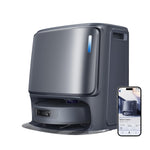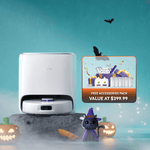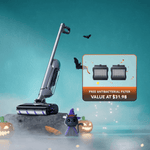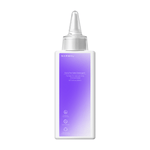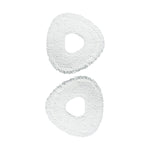Vacuum cleaner history begins in the mid-19th century, but it was British engineer Hubert Cecil Booth who invented the first powered vacuum cleaner in 1901, launching a new era of home hygiene. If you're wondering who invented the vacuum, what the first vacuum cleaner looked like, or how today's robotic vacuums evolved from bulky machines, you're in the right place.
This guide explores the full story behind the vacuum cleaner invention, including the early manual devices, breakthrough milestones, and key inventors like Booth, Spangler, Hoover, and Dyson. You’ll see how vacuum cleaners changed society—saving time, improving health, and transforming home life. We’ll dive into the technologies behind today’s smart models, and spotlight Narwal Flow, a cutting-edge vacuum mop robot that shows just how far innovation has come.
This article is built on credible historical sources and expert insights into vacuum cleaner engineering. Whether you're a tech enthusiast, history buff, or a homeowner exploring cleaning solutions, you'll gain a full picture of how suction, science, and smart automation came together to shape the future of cleaning.
Who Invented the Vacuum Cleaner and When?
The first powered vacuum cleaner was invented by British engineer Hubert Cecil Booth in 1901. His design used suction to remove dust and marked the beginning of modern vacuum technology. However, the idea of vacuum cleaning didn’t start with Booth. Earlier inventors had explored ways to clean carpets using manual or mechanical devices. Let’s look at the key figures who helped create the vacuum cleaner we know today.
Daniel Hess and the First Patent in 1860
In 1860, Daniel Hess from Iowa, USA, patented one of the earliest vacuum cleaning devices. It was called a “carpet sweeper” and used bellows and rotating brushes to collect dust from rugs. Although it didn't run on electricity, it introduced the idea of creating suction to pull dirt from surfaces.
Hess’s invention was fully manual. It required physical effort to operate and wasn't widely adopted. Still, it laid the foundation for future developments by showing that cleaning could go beyond just sweeping.
Booth’s Suction Machine in 1901: The First Real Vacuum Cleaner
In 1901, Hubert Cecil Booth designed and built a machine that used a motor to generate suction, pulling dust through a filter and trapping it. This machine, called the “Puffing Billy”, was huge—it had to be horse-drawn and parked outside a building while long hoses were fed inside through windows to clean.
Booth's invention was the first to truly clean using suction rather than blowing dust away or sweeping it manually. Though expensive and not suitable for homes at the time, it proved that suction-based cleaning was effective, launching a new era.
Spangler’s Portable Vacuum and Hoover’s Mass Production (1907–1908)
In 1907, American janitor James Murray Spangler created the first portable electric vacuum cleaner. It had a rotating brush, cloth filter bag, and an electric motor. This design was compact and easy to use in the home.
Spangler sold his design to William Henry Hoover, who refined the model and began mass production in 1908. Hoover added features like replaceable bags and improved suction, making the vacuum cleaner a common household item. In many countries, “Hoovering” even became another word for vacuuming.
What Was the First Vacuum Cleaner Like?
The first vacuum cleaner, invented by Hubert Cecil Booth in 1901, was large, noisy, and powered by a gasoline engine. It was designed for commercial use and was not something a typical household could own or operate. However, this machine introduced the core concept still used in modern vacuums: suction through a filter to remove dust and dirt.
Size, Engine, and Suction System
Booth’s machine, often called “Puffing Billy”, was built on a horse-drawn cart. It included a gasoline or electric motor, a piston pump, and a fabric filter to trap dirt. The engine produced a loud, chugging sound as it pulled air through long hoses and into the dust chamber. The entire system was roughly the size of a small carriage and required parking outside a building during operation.
This was the first time a machine used true suction—not blowing or sweeping—to clean.
How It Worked Inside Buildings
Once the machine was set up outside, operators would uncoil long canvas hoses, sometimes over 100 feet in length, and feed them through open windows or doors. An assistant inside would guide the hose across carpets, curtains, and upholstery, while the motor outside powered the suction.
The process required at least two people to operate and was labor-intensive. But compared to hand-beating rugs or sweeping, the results were far more effective and cleaner.
Who Used It: Wealthy Homes, Hotels, Hospitals
Because of its size and cost, the first vacuum cleaner was mostly used by:
-
Wealthy families who could afford door-to-door cleaning services
-
Luxury hotels aiming to impress guests with spotless rooms
-
Hospitals that needed better hygiene in patient areas
These clients valued the machine's ability to remove deep-set dust and allergens, something manual tools couldn’t achieve.
Why It Mattered: Proving Suction Works
Booth’s invention was not just about cleaning carpets—it was proof of concept. It demonstrated that using suction to clean was more efficient and hygienic than any previous method. Even though the machine was impractical for regular home use, its core cleaning principle—airflow pulling dust through a filter—remains at the heart of every vacuum cleaner today.
A Complete Timeline of Vacuum Cleaner History
Vacuum cleaner history spans over 160 years, evolving from manual sweepers to AI-powered robotic cleaners. Each stage brought new innovations in suction, size, and usability. Below is a detailed timeline that highlights the most important milestones in the evolution of vacuum cleaner technology.
19th Century Origins (1860–1898): Manual Sweepers and Blowers
-
1860 – Daniel Hess patented a manual carpet sweeper with rotating brushes and bellows to generate suction. It was the first recorded effort to pull dust from surfaces rather than just move it.
-
1868 – Ives W. McGaffey developed the “Whirlwind,” a hand-cranked vacuum cleaner. It was among the first to be commercially sold but was difficult to use due to the crank mechanism.
-
1898 – John S. Thurman introduced a gasoline-powered blower used in a door-to-door cleaning service. Instead of suction, it blew dust into a container.
These early designs were primitive, but they reflected growing interest in mechanized cleaning.
Early 20th Century (1901–1930s): Powered and Portable Vacuums
-
1901 – Hubert Cecil Booth created the first powered suction vacuum, proving suction-based cleaning could be effective.
-
1907 – James Murray Spangler invented the first portable electric vacuum, which was later commercialized by William Hoover in 1908.
-
The 1930s saw the introduction of disposable filter bags, improving cleanliness and convenience for users.
This period established the basic form and function of the vacuum cleaner as a household appliance.
Mid-20th Century (1950s–1980s): Home Adoption and New Designs
-
1950s–60s: Vacuum cleaners became affordable for the average home, thanks to mass production and economic growth.
-
Upright and canister vacuums became standard, offering more power and better maneuverability.
-
Manufacturers introduced various attachments, making it easier to clean stairs, upholstery, and drapes.
Vacuum cleaners became a must-have appliance in homes during this time.
Late 20th Century (1990s): Cordless and Bagless Innovations
-
1980s–90s: Cordless vacuums emerged, allowing quick and convenient cleaning.
-
1993 – James Dyson launched the first successful bagless vacuum cleaner using cyclonic separation to maintain strong suction.
-
HEPA filters became common, improving air quality by capturing fine allergens.
These innovations made vacuums more powerful, efficient, and user-friendly.
21st Century: Robotic and Smart Vacuums Emerge

-
2002 – iRobot Roomba introduced the first widely adopted robot vacuum, allowing autonomous cleaning.
-
2020 – Narwal launched the world’s first self-cleaning vacuum mop robot, combining vacuuming and mopping with auto-washing.
-
2024 – Narwal S20 Pro and Freo Z Ultra introduced advanced AI, stronger suction, and real-time mess detection, showing the future of smart cleaning.
[cta:narwal-s20-pro-vacuum-mop]
Modern vacuums now include mapping, app controls, self-cleaning systems, and voice integration, making cleaning easier and smarter than ever.
[cta:narwal-freo-z-ultra-robotic-vacuum-and-mop-cleaner-clean-before-you-even-notice]
How Vacuum Cleaner Inventions Changed Homes and Society
The vacuum cleaner invention did more than clean carpets—it reshaped how people lived, worked, and thought about hygiene. From reducing manual labor to improving public health, the impact of vacuum cleaners has been both personal and societal.
Time and Labor Saving
Before vacuum cleaners, cleaning meant hours of sweeping, beating rugs, or scrubbing floors. These tasks were physically demanding and often inefficient.
The invention of the vacuum cleaner dramatically reduced the time and effort needed to clean a space. As vacuums became more portable and affordable, they allowed people to clean larger areas in less time, freeing up hours each week for other activities.
For households with domestic staff, vacuum cleaners also reduced reliance on labor-intensive chores, marking a shift in home management.
Health and Air Quality Improvements
Vacuum cleaners significantly improved indoor air quality by removing dust, pollen, pet dander, and other allergens from carpets and upholstery.
Models with HEPA filters became especially valuable for people with asthma or allergies, as they could capture particles that traditional sweeping simply redistributed.
In hospitals and public buildings, early vacuums helped support cleaner environments, reducing airborne germs and supporting better health outcomes.
Social Impact on Households and Cleaning Roles
As vacuum cleaners became affordable and easy to use, cleaning transitioned from a team effort to a solo, routine task. This shift:
-
Reduced dependency on hired help in middle-class homes
-
Encouraged more equal distribution of chores across family members
-
Reinforced the idea that clean homes were a sign of modern living
In some cultures, owning a vacuum cleaner became a symbol of progress and status.
Commercial and Institutional Use Cases
Beyond homes, vacuum cleaners transformed office buildings, hotels, schools, and hospitals. These spaces required frequent cleaning to maintain hygiene and aesthetics.
Vacuum cleaners made it possible to clean large floor areas quickly, contributing to:
-
Improved workplace health
-
Cleaner public environments
-
Growth of professional cleaning services
Overall, the invention and evolution of the vacuum cleaner made clean spaces accessible to everyone, not just the wealthy.
From Suction to Smart: The Technology Behind Modern Vacuum Cleaners
Modern vacuum cleaners are far more than machines that suck up dust. Today’s models combine advanced sensors, smart software, and self-maintenance systems to clean better with less effort. These improvements build on the same principle established in the early 1900s—suction plus filtration—but push the limits of what a vacuum can do.
Cyclonic Separation and HEPA Filters
One of the biggest breakthroughs came in 1983, when James Dyson introduced cyclonic separation. This technology spins air rapidly to separate dust from airflow without losing suction. It eliminated the need for dust bags and improved suction consistency.
HEPA filters became standard in many vacuums, especially for users concerned about allergens. These filters trap microscopic dust particles, pollen, and pet hair, ensuring cleaner air is released back into the room.
Cordless Design and Battery Efficiency
Older vacuums required long power cords and frequent re-plugging between rooms. Today’s cordless vacuums use high-capacity lithium batteries, giving users more freedom and convenience.
Modern batteries offer up to 90 minutes of runtime, with fast recharge cycles, making them suitable for daily cleaning without being tied to a power outlet.
Robotic Navigation, Mapping, and App Control
The rise of robotic vacuum cleaners has transformed floor care. Devices like the Roomba introduced basic autonomous cleaning, but newer models go further:
-
Use LiDAR or dual-camera systems to scan and map rooms in real time
-
Avoid obstacles, stairs, and tangled cords with AI-powered object recognition
-
Connect to mobile apps for scheduling, zone control, and cleaning history
These features allow users to clean specific rooms or areas with just a tap or voice command.
The Role of AI in Modern Cleaning Devices
AI is now central to how vacuums clean smarter. Algorithms help devices:
-
Identify floor types and adjust suction or mop pressure accordingly
-
Detect high-dirt zones and apply extra passes
-
Differentiate between solid and liquid messes
-
Optimize paths to reduce overlap and cleaning time
These improvements don’t just automate cleaning—they make vacuums adapt to the environment, just like a human would.
Narwal Flow and the Future of Home Cleaning
The latest generation of smart vacuum cleaners is all about automation, convenience, and real-time adaptation. Among them, Narwal Flow stands out by combining vacuuming, mopping, and self-cleaning features in one intelligent system. It builds on over a century of vacuum cleaner invention and takes the concept further with AI-powered automation.
[cta:narwal-flow-robot-vacuum-mop]
Dual Cleaning: Real-Time Self-Washing Mop
Unlike traditional vacuums that only handle dry debris, Narwal Flow performs vacuuming and mopping simultaneously. Its FlowWash Mopping System:
-
Cleans the mop heads with warm water and strong pressure during cleaning
-
Prevents dirt from being spread across the floor
-
Delivers consistently clean results without stopping for manual rinsing
This feature tackles one of the biggest frustrations with mopping robots: dirty mop reuse.
CarpetFocus and EdgeReach Technologies
Narwal Flow uses CarpetFocus Technology to:
-
Detect carpets automatically
-
Boost suction by 182%
-
Lift the mop head by 12mm to avoid wetting fabric surfaces
Its EdgeReach Track Mop ensures corners and wall edges are thoroughly cleaned, reaching as close as 5mm to edges—something many vacuums miss.
DualFlow Hair Management and Obstacle Avoidance
Hair tangling is a common issue in vacuums. Narwal solves this with the DualFlow Tangle-Free System, which:
-
Channels hair into the dustbin directly
-
Prevents hair from wrapping around the brush
-
Is independently certified by SGS to have a 0% tangle rate
Navigation is powered by TWINAI dual RGB cameras and an AI chip that recognizes 200+ object types, such as socks, cables, or pet waste, with 0.19-inch precision.
120-Day Maintenance-Free Station
Narwal Flow includes a maintenance-free base station that:
-
Automatically washes and dries the mop heads
-
Stores dust for up to 120 days
-
Exchanges dirty water with clean water
-
Uses hot water and warm-air drying for hygiene and odor control
This drastically reduces how often users need to interact with the machine.
Smart Home Integration and Voice Control
Narwal Flow integrates with:
-
“Hey Nawa” voice assistant
-
Amazon Alexa, Siri, Google Assistant, and Matter protocol
With voice commands, users can start or stop cleaning, target specific rooms, and even check cleaning status—all hands-free.
Key Milestones and Inventors in Vacuum Cleaner History
The history of the vacuum cleaner is shaped by inventors who introduced new ideas and solved old problems. From the first patents to today’s AI-driven systems, each innovation has built on the last. The table below highlights the key inventors, their contributions, and the long-term impact of their work on vacuum cleaner invention and evolution.
|
Year |
Inventor |
Invention or Contribution |
Lasting Impact |
|
1860 |
Daniel Hess |
Patented a carpet sweeper using bellows and brushes |
Introduced suction-based cleaning idea |
|
1868 |
Ives W. McGaffey |
Developed the “Whirlwind,” a hand-cranked vacuum |
One of the first vacuums sold commercially |
|
1898 |
John S. Thurman |
Created a gasoline-powered blower for cleaning services |
Used in commercial cleaning, showed market interest |
|
1901 |
Hubert Cecil Booth |
Built the first powered suction vacuum (“Puffing Billy”) |
Proved suction was effective for cleaning |
|
1907 |
James Murray Spangler |
Invented first portable electric upright vacuum |
Practical design for home use |
|
1908 |
William H. Hoover |
Bought Spangler’s patent, mass-produced upright vacuums |
Made vacuum cleaners a household standard |
|
1983 |
James Dyson |
Launched bagless vacuum with cyclonic separation |
Solved suction loss, revolutionized airflow design |
|
2002 |
iRobot |
Released the first successful robot vacuum (Roomba) |
Popularized autonomous home cleaning |
|
2020 |
Narwal |
Launched world’s first self-cleaning vacuum mop robot |
Combined vacuuming, mopping, and auto-maintenance in one |
These milestones show that vacuum cleaner history is not just about machines, but about continuous problem-solving and innovation.
Summary: From the First Vacuum Cleaner to Smart Robots
The story of the vacuum cleaner is a journey from manual carpet sweepers to AI-powered smart robots. Each invention improved how we clean, making it faster, easier, and more hygienic.
-
The first vacuum cleaner, invented in 1901 by Hubert Cecil Booth, used suction to remove dust—a principle still used today.
-
Early inventors like Daniel Hess, James Murray Spangler, and William Hoover turned bulky prototypes into practical home appliances.
-
Over time, vacuum cleaner history moved from corded uprights to cordless, bagless, and eventually robotic systems with sensors and mapping.
-
Smart models from brands like Narwal now combine vacuuming, mopping, AI object detection, and self-cleaning—all in one device.
These innovations show that the vacuum cleaner invention has always followed the same goal: make cleaning easier and more effective. As technology evolves, the focus has shifted from simply removing dirt to creating intelligent systems that understand the home environment and clean it with minimal effort.
Whether you're curious about who invented the vacuum, how the first vacuum cleaner worked, or where cleaning tech is headed, one thing is clear: this is a story of progress built on practical ideas, powerful designs, and smart problem-solving.
When did Siemens launch its first vacuum cleaner?
Siemens released its first electric vacuum cleaner in 1906, just five years after Hubert Cecil Booth introduced the first powered suction machine. This made Siemens one of the earliest companies to enter the home cleaning technology space.
Who developed a vacuum cleaner in the 1920s?
During the 1920s, several manufacturers refined portable electric vacuum cleaners, improving suction power, motor efficiency, and weight. Brands like Hoover led the charge, helping vacuums become more affordable and widespread in middle-class homes.
How much did the first vacuum cleaner cost?
Early powered vacuum cleaners, like Booth’s 1901 model, were extremely expensive—often costing the equivalent of several months’ wages. This limited their use to wealthy households, hotels, and institutions.
Were vacuum cleaners common in the 1950s?
Yes. By the 1950s, vacuum cleaners had become standard appliances in many homes, especially in the United States and Europe. Mass production, rising incomes, and the post-war housing boom all contributed to their adoption.
What was a carpet sweeper and why was it important?
A carpet sweeper was a manual cleaning tool invented in the 19th century. It used rotating brushes to lift surface dirt from carpets without suction. It was a crucial step between basic brooms and powered vacuums, helping to mechanize cleaning before electricity was common.
Who first came up with the scientific concept of a vacuum?
The concept of a vacuum was demonstrated in 1643 by Italian physicist Evangelista Torricelli, who invented the mercury barometer. His experiment proved that empty space (a vacuum) could exist—a foundational idea for later vacuum-based technologies.

































